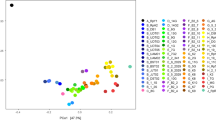Abstract
A lytic podophage RSPI1 was isolated from tobacco field soil collected in Fujian Province, South China using host bacterium Ralstonia solanacearum Tb15-14. Whole genome sequencing of this phage was performed using the high-throughput Ion Torrent PGM Sequencer. The complete genome of RSPI1 was 43,211 bp in length with a mean DNA G + C content of 61.5%. A total of 48 open reading frames were identified with lengths ranging from 132 bp to 5,061 bp, of which, 11, 12 and 25 were identified as functional, structural and unknown genes, respectively. A BLAST analysis revealed that this phage genome had a query cover of 78–79% and a highest identity of 84% with four podophages that infect Burkholderia pseudomallei. Two neighbor-joining phylogenetic trees were constructed using phage DNA polymerase I and tail fiber protein sequences and showed that this phage is closely related to Burkholderia phage Bp-AMP1, and also related to several phages that infect Ralstonia solanacearum. These findings indicate that RSPI1 is a novel phage that infects the notorious plant pathogen Ralstonia solanacearum.


Similar content being viewed by others
References
D’Herelle F (1917) Sur un microbe invisible antagoniste des bacilles dysentériques. Compte Rend Acad Sci Paris 165:373–375
Fegan M, Prior P (2005) “How complex is the Ralstonia solanacearum species complex?”. In: Allen C, Prior P, Hayward AC (eds) Bacterial wilt disease and the Ralstonia solanacearum species complex. APS Press, St. Paul, pp 449–461
Fischetti VA (2001) Phage antibacterials make a comeback. Nat Biotechnol 19(8):734–735
Fujiwara A, Kawasaki T, Usami S, Fujie M, Yamada T (2008) Genomic characterization of Ralstonia solanacearum phage φRSA1 and its related prophage (φRSX) in strain GMI1000. J Bacteriol 190(1):143–156
Hayward AC (2000) Ralstonia solanacearum. Academic Press, San Diego
Kawasaki T, Shimizu M, Satsuma H, Fujiwara A, Fujie M, Usami M, Yamada T (2009) Genomic characterization of Ralstonia solanacearum phage φRSB1, a T7-like wide-host-range phage. J Bacteriol 191(1):422–427
Kropinski AM, Mazzocco A, Waddell TE, Lingohr E, Johnson RP (2009) Enumeration of bacteriophages by double agar overlay plaque assay. Methods Mol Biol 501:69–76
Meyer F, Paarmann D, D’Souza M, Olson R, Glass EM, Kubal M, Paczian T, Rodrigucz A, Stcvcns R, Wilkc A, Wilkcning J, Edwards RA (2008) The metagenomics RAST server–a public resource for the automatic phylogenetic and functional analysis of metagenomes. BMC Bioinform 9(1):386
Mizuno CM, Rodriguez-Valera F, Kimes NE, Ghai R (2013) Expanding the marine virosphere using metagenomics. PLoS Genet 9(12):e1003987
Patel RK, Jain M (2012) NGS QC Toolkit: a toolkit for quality control of next generation sequencing data. PLoS One 7(2):e30619
Stone R (2002) Stalin’s forgotten cure. Science 298(5594):728–731
Stothard P, Wishart DS (2005) Circular genome visualization and exploration using CGView. Bioinformatics 21(4):537–539
Su JF, Liu JJ, Yu H, Guo ZK, Sun HW, Fan GQ, Gu G, Wang GH (2017) Isolation and whole genome sequencing analysis of a novel lytic bacteriophage RS-PII-1 infecting Ralstonia solanacearum. China J Virol 33(3):441–449 (in Chinese with English abstract)
Summers WC (2001) Bacteriophage therapy. Annu Rev Microbiol 55(1):437–451
Tamura K, Peterson D, Peterson N, Stecher G, Nei M, Kumar S (2011) MEGA5: molecular evolutionary genetics analysis using maximum likelihood, evolutionary distance, and maximum parsimony methods. Mol Biol Evol 28(10):2731–2739
Thi BVT, Khanh NHP, Namikawa R, Miki K, Kondo A, Thi PTD, Kamei K (2016) Genomic characterization of Ralstonia solanacearum phage ϕRS138 of the family Siphoviridae. Arch Virol 161(2):483–486
Villa JE, Tsuchiya K, Horita M, Natural M, Opina N, Hyakumachi M (2005) Phylogenetic relationships of Ralstonia solanacearum species complex strains from Asia and other continents based on 16S rDNA, endoglucanase, and hrpB gene sequences. J Gen Plant Pathol 71(1):39–46
Yabuuchi E, Kosako Y, Yano I, Hotta H, Nishiuchi Y (1995) Transfer of two Burkholderia and an Alcaligenes species to Ralstonia gen. nov.: proposal of Ralstonia pickettii (Ralston, Palleroni and Doudoroff 1973) comb. nov., Ralstonia solanacearum (Smith 1896) comb. nov. and Ralstonia eutropha (Davis 1969) comb. nov. Microbiol Immunol 39(11):897–904
Zhang XL, Guo XF, Fan H, Zhao QM, Zuo SQ, Sun Q, Pei GQ, Cheng S, An XP, Wang YF, Mi ZQ, Huang Y, Zhang ZY, Tong YG, Zhou HN, Zhang JS (2017) Complete genome sequence of Menghai flavivirus, a novel insect-specific flavivirus from China. Arch Virol 162(5):1–5
Zhang XL, Wang YH, Li SS, An XP, Pei GQ, Huang Y, Fan H, Mi ZQ, Zhang ZY, Wang W, Chen YB, Tong YG (2015) A novel termini analysis theory using HTS data alone for the identification of Enterococcus phage EF4-like genome termini. BMC Genom 16:414
Acknowledgements
The authors thank the members of Professor Yigang Tong’s group in the Beijing Institute of Microbiology and Epidemiology for help conducting sequence analysis.
Author information
Authors and Affiliations
Corresponding author
Ethics declarations
Funding
This study was funded by the Key Project of Science and Technology of China National Tobacco Corporation (Grant number 110201402014).
Conflict of interest
All authors declare that they have no conflict of interest.
Ethical approval
This article does not contain any studies with human participants or animals performed by any of the authors.
Additional information
Handling Editor: Horst Neve.
Nucleotide sequence accession numbers:
The complete genome sequence of phage RSPI1 was deposited into the GenBank database under accession number KY464836.
Electronic supplementary material
Below is the link to the electronic supplementary material.
Rights and permissions
About this article
Cite this article
Su, J., Sun, H., Liu, J. et al. Complete genome sequence of a novel lytic bacteriophage isolated from Ralstonia solanacearum . Arch Virol 162, 3919–3923 (2017). https://doi.org/10.1007/s00705-017-3555-2
Received:
Accepted:
Published:
Issue Date:
DOI: https://doi.org/10.1007/s00705-017-3555-2




